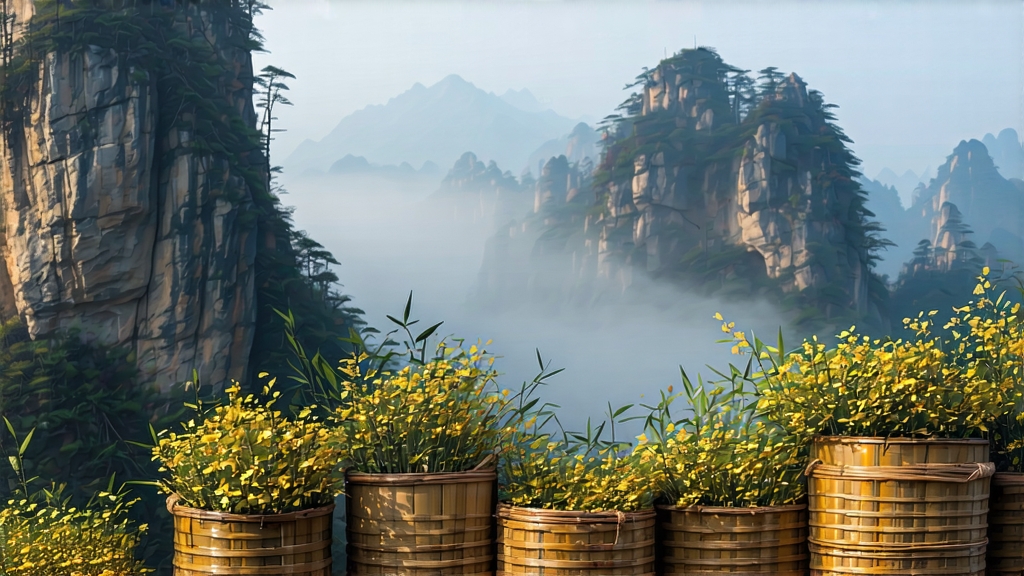
Tucked high in the mist-veiled Dabie Mountains of western Anhui Province, Huoshan Huangya has been whispered about in Chinese tea circles for more than fourteen centuries. Foreign drinkers often rush to name green, black, oolong or pu-erh when asked to list Chinese teas, yet the tiny family of yellow teas—only three counties still make it authentically—remains one of the country’s best-kept secrets. Among them, Huoshan Huangya, literally “Huoshan Yellow Bud,” is the most luminous: a tea once reserved for Tang-dynasty emperors, later freighted down the Yangtze to pay imperial tribute, and today protected under China’s National Geographical Indication. To understand it is to witness a process so laborious that fewer than thirty households still master it, and to taste a liquor so soft that even lifelong green-tea drinkers lower their voice, as though speaking in a library.
History and myth intertwine from the first written record in 780 CE when Lu Yu, the “Sage of Tea,” noted that “Huoshan carries buds of pale gold, sweet like pear blossom water.” During the Ming dynasty the tea was steamed, pressed into cakes and sent south along the Cha-ma古道, the ancient tea-horse road; Qing archives list it among the eight “court teas” presented at the New Year audience. Legend claims that when the Guangxu Emperor tasted it in 1890 he remarked, “It is as if spring itself were imprisoned in a cup,” and annual tribute of 120 jin (60 kg) was fixed. Revolution, war and market neglect nearly erased the craft after 1949; in 1972 the county government located two octogenarian tea masters who could still recall the full firing choreography, and from three withered bushes behind a Taoist monastery they revived the lineage. By 2006 slow-food scholars in Italy placed Huoshan Huangya on the Ark of Taste, and today micro-lots sell at pre-auction in Shanghai for more per gram than silver.
The cultivar itself is a local seed-selected variety called “Jin Ji Zhong,” Golden Chicken Breed, whose small, thick leaves tolerate the high-altitude chill. Gardens sit between 600 and 800 m where diurnal swings reach 15 °C, locking in amino acids; morning fog filters UV light, reducing tannin and coaxing a signature lactone aroma reminiscent of steamed corn milk. Soils are yellow-granitic, porous and poor in nitrogen—exactly the stress vines and tea bushes need to concentrate flavor. Farmers plant every seventh row with sweet osmanthus and bamboo, luring predatory insects so that pesticides are unnecessary; the entire county is certified under China’s Green Food standard, the strictest national organic protocol.
Picking rules are draconian: only the single bud and imminent first leaf, plucked between the Qingming and Grain Rain solar terms (roughly 5–20 April), before 10 a.m. while dew still glistens. A skilled picker gathers barely 500 g fresh weight in an hour; it takes 55,000 buds to yield one kilogram of finished tea. Leaves are immediately laid on shallow bamboo trays in mountain huts whose windows are shuttered to keep humidity around 78 %. Here the first and most secret stage—menhuang, literally “sealed yellowing”—begins. Unlike green tea, which is quickly pan-fired to kill-green, Huoshan Huangya is lightly roasted at 85 °C for just 90 seconds to deactivate only 60 % of oxidative enzymes. The leaves are then wrapped in stacks of steamed canvas and left to breathe in cycles: 40 minutes wrapped, 20 minutes unwrapped, repeated five times over 36 hours. During this micro-fermentation chlorophyll quietly degrades into pheophytin, catechins dimerize into theaflavins, and a faint golden down—visible only under slanted light—emerges on each bud. The result is neither green nor black, but a spectral yellow that seems to glow from within.
Next comes the “three firings and one dewing” choreography. First firing: charcoal embers at 120 °C, hand-tossed in a wok for three minutes to lock the yellow hue. Second firing: temperature dropped to 90 °C, the master rolls the leaves along the wok’s rim until they curl into tiny hooks that tinkle like bells when dropped onto porcelain. Between firings the tea